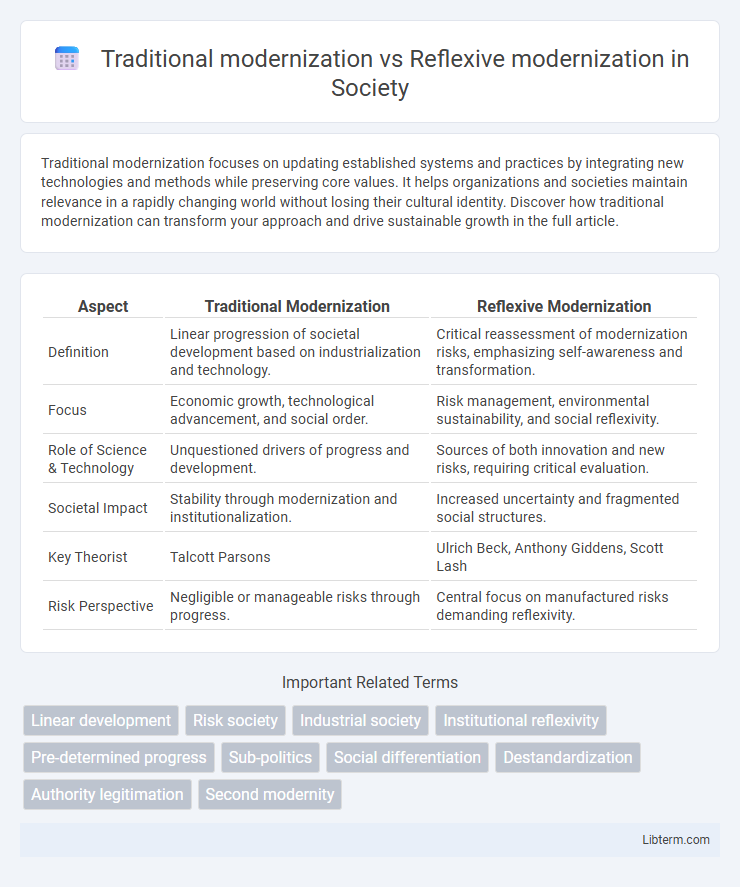Traditional modernization focuses on updating established systems and practices by integrating new technologies and methods while preserving core values. It helps organizations and societies maintain relevance in a rapidly changing world without losing their cultural identity. Discover how traditional modernization can transform your approach and drive sustainable growth in the full article.
Table of Comparison
| Aspect | Traditional Modernization | Reflexive Modernization |
|---|---|---|
| Definition | Linear progression of societal development based on industrialization and technology. | Critical reassessment of modernization risks, emphasizing self-awareness and transformation. |
| Focus | Economic growth, technological advancement, and social order. | Risk management, environmental sustainability, and social reflexivity. |
| Role of Science & Technology | Unquestioned drivers of progress and development. | Sources of both innovation and new risks, requiring critical evaluation. |
| Societal Impact | Stability through modernization and institutionalization. | Increased uncertainty and fragmented social structures. |
| Key Theorist | Talcott Parsons | Ulrich Beck, Anthony Giddens, Scott Lash |
| Risk Perspective | Negligible or manageable risks through progress. | Central focus on manufactured risks demanding reflexivity. |
Introduction to Modernization Theories
Traditional modernization theory emphasizes linear progress through industrialization, urbanization, and rationalization, viewing societal development as a move from traditional to modern stages. Reflexive modernization challenges these assumptions by highlighting the risks and uncertainties of technological and social change in contemporary societies, focusing on self-awareness and critical reflection within modernization processes. Key theorists like Anthony Giddens and Ulrich Beck argue that modernity now involves continuous transformation shaped by global interdependencies and reflexive responses to modernization's unintended consequences.
Defining Traditional Modernization
Traditional modernization refers to the process of societal development characterized by linear progression through industrialization, urbanization, and bureaucratic rationalization. This model emphasizes economic growth, technological advancement, and the transformation from agrarian to industrial societies as primary indicators of development. It assumes a stable framework where social institutions adapt predictably to technological and economic changes, aiming for increased efficiency and social order.
Core Principles of Reflexive Modernization
Reflexive modernization emphasizes self-awareness and critical reflection within societies about the risks and contradictions produced by technological and social progress. Unlike traditional modernization, which focuses on linear development and industrial growth, reflexive modernization addresses the unintended consequences of modernity, such as environmental degradation and social inequalities, fostering adaptive and sustainable solutions. Core principles include the process of continuous self-examination, institutional reflexivity, and embracing complexity to navigate the evolving challenges of modern life.
Historical Context and Evolution
Traditional modernization emerged during the Industrial Revolution, emphasizing linear progress through technological advancement and economic growth rooted in Enlightenment ideals. Reflexive modernization, a concept developed in late 20th-century sociology, critiques the unintended consequences of industrialization, highlighting self-critical adjustments in society, such as environmental concerns and risk management. This shift reflects historical evolution from unquestioned belief in progress to a more complex awareness of modernization's systemic challenges and reflexive responses.
Key Differences Between Traditional and Reflexive Modernization
Traditional modernization centers on industrial growth, technological advancement, and social progress driven by rational planning and linear development. Reflexive modernization critically examines the unintended consequences of modernization, emphasizing self-awareness, risk assessment, and the transformation of societal institutions. Key differences include traditional modernization's focus on external economic growth versus reflexive modernization's attention to internal critiques and adaptive responses to environmental and social challenges.
Social and Cultural Impacts
Traditional modernization emphasizes industrial growth and urbanization, leading to established social hierarchies and cultural homogenization. Reflexive modernization challenges these structures by promoting individualization, risk awareness, and cultural pluralism, reshaping identity and community bonds. This shift encourages critical self-examination of institutions and values, profoundly influencing social norms and cultural dynamics in contemporary societies.
Economic Implications and Adaptations
Traditional modernization centers on industrial growth, market expansion, and resource exploitation, leading to standardized economic structures and predictable labor markets. Reflexive modernization emphasizes innovation, sustainability, and risk management, pushing economies toward adaptive technologies and flexible organizational models to address global environmental and social challenges. Economic adaptations under reflexive modernization include investing in green technologies, promoting circular economies, and fostering resilience against systemic uncertainties and crises.
Environmental Considerations in Both Models
Traditional modernization emphasizes industrial growth with limited attention to environmental degradation, often prioritizing economic development over ecological sustainability. Reflexive modernization critiques these consequences by integrating environmental risks into decision-making, promoting sustainable technologies and policies to mitigate ecological damage. This model encourages continuous societal self-assessment to address environmental challenges inherent in modernization processes.
Challenges and Critiques of Each Approach
Traditional modernization faces challenges such as environmental degradation, social inequality, and cultural homogenization due to its linear progression model emphasizing industrial growth and Western-centric values. Reflexive modernization critiques these issues by highlighting risks and unintended consequences but struggles with practical implementation complexities and a perceived elitism that limits broader societal engagement. Both approaches encounter difficulties balancing progress with sustainability, equity, and inclusivity in a rapidly changing global context.
Future Trends in Modernization Theory
Traditional modernization emphasizes linear economic growth and industrial development as key drivers of societal progress, while reflexive modernization highlights the self-critical reassessment of modern institutions and the adaptation to risks generated by modernization itself. Future trends in modernization theory prioritize the integration of environmental sustainability, digital transformation, and global interconnectedness, recognizing the complex, multi-directional nature of social change and governance. Emerging frameworks focus on resilience, adaptive governance, and reflexivity to address challenges posed by climate change, technological disruptions, and socio-political uncertainties.
Traditional modernization Infographic

 libterm.com
libterm.com